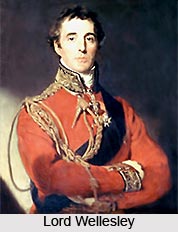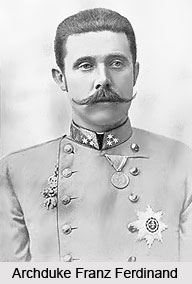 Indian Army in First World War, also known as the British Indian Army, contributed significantly a number of independent brigades and divisions. The assassination of Archduke Franz Ferdinand, the heir apparent to the Austrian Empire, at Sarajevo on 28th June, 1914 in Bosnia was the main cause of the First World War. Tension between the major European power had, however, been growing for some time, fuelled mainly by Germany`s ambition to be the major power in Europe and as a competitor to Britain in commerce and trade. This had led to the formation of two power blocks in Europe, the Triple Alliance of Germany, Austria and Hungary; and the Triple Entente of England, French and Russia.
Indian Army in First World War, also known as the British Indian Army, contributed significantly a number of independent brigades and divisions. The assassination of Archduke Franz Ferdinand, the heir apparent to the Austrian Empire, at Sarajevo on 28th June, 1914 in Bosnia was the main cause of the First World War. Tension between the major European power had, however, been growing for some time, fuelled mainly by Germany`s ambition to be the major power in Europe and as a competitor to Britain in commerce and trade. This had led to the formation of two power blocks in Europe, the Triple Alliance of Germany, Austria and Hungary; and the Triple Entente of England, French and Russia.
Britain entered the war on 4th of August 1914 by sending an expeditionary force for divisions to fight alongside the French. At this time the only regular forces available to the British were their own army and Indian Army. The Indian Army fought in all the major theatres of war where Britain was engaged. The Germans war plans had called for the early defeat of the France by a sweeping manoeuvre through Belgium and northern French. Successive efforts by each side to outdo the other led to what came to be called the `Race to the sea`; eventually leading to a nearly unbroken line of defences from the North sea to the Alps.
The war now deteriorated into a series of effort to frontally break through the enemy defences. Artillery, the machine gun and barbed wire made these efforts costly in manpower and casualties suffered were on a scale not imagined nor catered for. The small regulatory peacetime British Army was soon hard pressed and Britain called on the only other trained manpower readily available, the Indian Army. During the First World War around 40,000 Indian Army troops were deployed on various fronts oversees. Though initially they moved into the theatres of war ill trained and ill-equipped, they rose to various challenges with dexterity and fervour, to be fully equipped and trained in due course.
 The first major battle in which Indian troops took part was the First Battle of Ypres, a small market town in Flanders bordering present day Belgium. Troops of the Indian Corps were fully committed there and suffered heavy causalities. In the Middle East, units of Indian Army and many of the Princely States were deployed for the defence of Suez Canal and for operations in Gallipoli, Persia, Mesopotamia, Palestine and East Africa. In Egypt and East Africa Indian Army troops were deployed throughout the war for the defence of Suez Canal, operations in Gallipoli and for various campaigns in Africa including that of Kilimanjaro. At the Palestine and Syrian fronts they participated in the battles of Jerusalem, Gaza, Megido, Sharon and Hafia.
The first major battle in which Indian troops took part was the First Battle of Ypres, a small market town in Flanders bordering present day Belgium. Troops of the Indian Corps were fully committed there and suffered heavy causalities. In the Middle East, units of Indian Army and many of the Princely States were deployed for the defence of Suez Canal and for operations in Gallipoli, Persia, Mesopotamia, Palestine and East Africa. In Egypt and East Africa Indian Army troops were deployed throughout the war for the defence of Suez Canal, operations in Gallipoli and for various campaigns in Africa including that of Kilimanjaro. At the Palestine and Syrian fronts they participated in the battles of Jerusalem, Gaza, Megido, Sharon and Hafia.
At the Persian front, where Indian troops were deployed throughout the war, they again performed splendidly. At the outset of the war Russian troops had occupied most of northern Persia, despite their declaration of neutrality. When Turkey entered the war Indian troops were deployed in the north-western coast of Persian Gulf so as to protect British oil interests, contain the Russians and to obtain a base for operations in Mesopotamia. In all these fronts Indian Army troops performed wonderfully.
Indian Army after First World War
When the war ended the Indian Army was once again reorganised to improve the system of command; achieve better balance between the fighting arms and services; to update arms and equipment and to develop a system of continuous reinforcement and expansion during war. The army was now divided into four commands - Northern, Eastern, Western and Southern. In 1920 the Indian Territorial Force (ITF) was raised for home defence and garrison duties, while Auxiliary Forces (India AFs) continued to be in charge of internal security. First World War, however, had shown glaring deficiencies in the organisation and administration of the army. Efforts to set these right now started in earnest. One of the greatest deficiencies had been in the system of recruit training and maintenance of reserves. This was sought to be set right by introducing a Regimental system.
With regards State Forces, prior to the inception of Indian Army based on the British model, most of the Princely States had their own armies to include infantry, artillery and cavalry units amongst other logistic units or sub units. While expanding their influence over India, the British augmented their own armies through local recruitment in order to effectively fight some of these very state armies who dared to oppose their advance. With the establishment of the British power in most part of India, the Indian States reconstituted their armies with the implementation of the Subsidiary Alliance by Lord Wellesley, under which the Indian States were required to maintain forces for the use of the Imperial power. In some cases, where the states were unable to ensure regular finances for their forces, funds were provided or large tracts of land were ceded for their maintenance. Many of these State Force units and sub-units performed splendidly in a number of campaigns in India and overseas, particularly during the two World Wars.




















